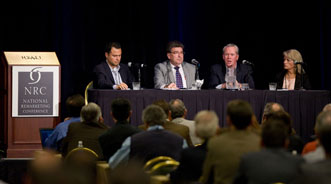Top Remarketing Execs Share Industry Trends on Opening Keynote NRC Panel

SAN DIEGO –
The final panel of the opening day of the National Remarketing Conference was a keynote panel featuring top remarketing executives, including Jeannie Chiaromonte, of Bank of America; Horacio Trujillo, of Mercedes-Benz Financial; Dan Kennedy, of GM Remarketing; and Bob Graham, of ARI.
Kennedy said one of the big changes occurring at GM Remarketing is that in 2008, the automaker stopped running cars down the lane in closed sales. The sales became more online-based. Due to dealer response, Kennedy said GM Remarketing decided to go back to running cars down the lane in closed sales.
“We’ve received a lot of positive response to going back to normal sales,” he explained.
Meanwhile, Chiaromonte said her team has been dealing with a 20-percent reduction in repossessions running through the lanes.
Over at ARI, Graham is predicting his fleet partners will soon have to purchase new vehicles and turn their used models in. He said ARI’s portfolio tends to be more truck-based, including light and medium-duty trucks, as well as larger trucks.
Since his company’s units tend to be a bit older and with more mileage, a lot of the buyers seeking out ARI’s units are generally buy-here, pay-here dealers, he noted.
“We use more venues than probably anyone else in the business. We don’t have big sales. And our inventory has been cut in half. It’s been a real challenge having even smaller sales,” Graham highlighted.
In some positive news, Trujillo said Mercedes-Benz Financial has seen about a 50-percent reduction in repossessions over the last year.
“Gone are the days we negotiate or beg our customers to keep our cars because we can now hand them off to dealers. We focus on a soft landing of the units,” he told attendees.
He went on to say the automaker has a very successful certified pre-owned program.
“We’re spending about three times more fixing cars (or reconditioning them), which is leading to positive ROI results. The key is to make the dealer comfortable buying the car. We spend an average of $500 on reconditioning,” Trujillo pointed out.
As for GM Remarketing, Kennedy said his team’s goal is to make the automaker’s cars “stand tall.”
In GM closed sales, the vehicles have been repaired so the dealers can get the units out to the frontline quickly. He noted that the automaker offers pre-CPO vehicles, which means the units are pretty much ready to be put into GM’s CPO program and sold very quickly by the dealers. Another aspect of the program at GM Remarketing is Sponsor Plus. For this program, GM ensures all the cosmetic work is done, but leaves the mechanical work up to the dealers.
Graham said his team doesn’t do that much reconditioning because it doesn’t always make sense for the dealers. This way, the dealer can do the work he feels needs done for his customers and for his market.
Chiaromonte said her team is spending an average of $30 more on reconditioning this year.
For her dealers, she said the condition report is vital. One of the important factors is ensuring that new photos have been taken and the CR has been updated after repair work is done. This is so dealers online, as well as those in the lane, can see that the vehicle has been reconditioned.
All the executives said they utilize online auction venues as well as physical venues.
Finally, the executives agreed that in some cases the used-vehicle prices are coming close to new-vehicle prices with the values so high at auctions.
For instance, Kennedy said, “the price of used vehicles is starting to bump into new vehicles.”
Trujillo pointed out, “We’re seeing the same thing. But we’re still doing many things in a traditional way. We need to decide on transformative changes now while volumes are low. We’re using some tech now, but we need to study the value chain and see what we can do.”
Subscribe to receive our daily e-newsletter and never miss the latest industry news, trends, and insights across the used-car and remarketing space.


